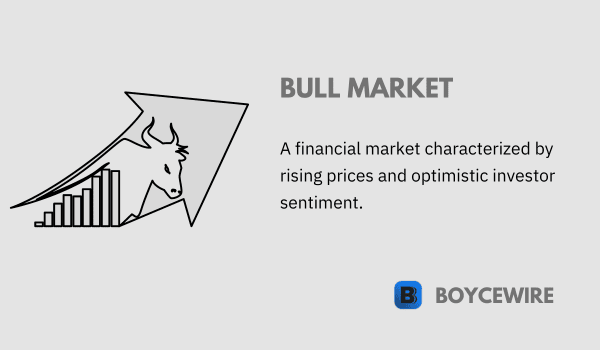Bull Market: Definition, Characteristics & Examples

What is a Bull Market?
A bull market refers to a financial market, or segment of a market, in which prices are rising or are expected to rise. The term is most commonly used in reference to the stock market, but it can also apply to anything that is traded, such as bonds, real estate, commodities, or foreign exchange (forex).
In a bull market, investor confidence is high. Investors are actively purchasing securities with the expectation that those securities will rise in value and can be sold later at a profit. This optimism and increased buying activity can further fuel the upward trend, creating a positive feedback loop.
The exact definition can vary, but many analysts consider a market to be “bullish” if it has risen by 20% or more from a recent low. Conversely, a decrease of 20% or more from a recent high typically signifies a bear market, which is the opposite of a bull market.
Bull markets can occur as a result of an economic recovery, an economic boom, or investor psychology. They can lead to significant financial gains for investors but also pose risks as market sentiment can change, and excessive optimism can create price bubbles.
Key Points
- Bull markets are characterized by a sustained period of rising stock prices and overall market optimism.
- Investors tend to be confident and optimistic during bull markets, leading to increased buying activity.
- Bull markets are often driven by positive economic indicators, such as strong GDP growth, low unemployment rates, and favorable corporate earnings.
Understanding the Bull Market
A bull market is a period in the financial markets characterized by a significant rise in asset prices, optimism among investors, and a strong economy. The term “bull market” is most often used to refer to the stock market, but it can apply to anything that is traded, such as bonds, real estate, commodities, or currencies.
The terminology of “bull” and “bear” markets originates from the way these animals attack their opponents. A bull thrusts its horns up into the air, while a bear swipes its paws downward. Thus, these actions are metaphors for the movement of a market: if the trend is up, it’s a bull market; if the trend is down, it’s a bear market.
Bull markets often begin before economic recovery is complete and typically continue until they peak, usually in anticipation of a downturn. The general rule of thumb for identifying a bull market is a sustained increase of 20% or more in broad market indexes such as the Dow Jones Industrial Average or the S&P 500.
While the overall trend is upward, it doesn’t mean that the market only moves in one direction. There can be days, weeks, or even months where the market experiences downturns. However, these temporary downturns, often called “corrections,” are typically followed by even higher highs.
During bull markets, investors tend to feel confident and are willing to invest more, contributing to further growth. This investor sentiment can often reflect or even lead to economic expansion, as businesses are better able to raise funds, invest, and create jobs. It’s important, however, to note that prolonged bull markets can lead to overconfidence, potentially causing excessive risk-taking and speculative bubbles.
Characteristics of a Bull Market
A bull market is more than just an increase in prices; it has several distinctive features and trends that set it apart. Here are some of the key characteristics:
- Rising Prices This is the most obvious sign of a bull market. Generally, a rise of 20% or more in broad stock market indices, such as the S&P 500 or the Dow Jones Industrial Average, over a period of at least two months, is considered indicative of a bull market.
- High Trading Volume In a bull market, the volume of shares traded is usually high. As investor confidence grows, more people are willing to buy stocks, which increases trading volume.
- Investor Confidence Optimism and confidence are key hallmarks of a bull market. Investors have a positive outlook for the future performance of the market, leading to increased buying activity.
- Economic Strength These markets often coincide with periods of economic strength or recovery. Key economic indicators, such as GDP growth, employment rates, and corporate earnings, tend to be positive.
- Supply and Demand In a bullish market, the demand for securities outstrips the supply. This is largely driven by investor psychology and the “fear of missing out” on potential gains.
- Sector Leadership During a bull market, specific sectors often lead the way. For instance, in the early stages of economic recovery, cyclical sectors such as consumer discretionary and technology often outperform.
- Low Interest Rates Bull markets are often supported by low interest rates, which decrease the cost of borrowing, encourage spending, and make stocks more attractive compared to other assets like bonds.
Understanding these characteristics can help investors recognize a bull market and make informed decisions. However, it’s important to note that no two bull markets are the same, and these characteristics may not all be present at the same time. It’s also crucial to remember that past performance is not a guarantee of future results.
Causes of a Bull Market
Bull markets are driven by a combination of numerous economic, political, and psychological factors. Some of the most common causes of bullish markets include:
- Economic Recovery and Growth Bull markets often coincide with periods of strong economic performance. When the economy is doing well, companies typically see increased profits, which can drive up stock prices.
- Low Interest Rates Lower interest rates reduce the cost of borrowing money, encouraging businesses and individuals to take on more debt to invest, spend, and stimulate economic growth. Additionally, lower interest rates make stocks a more attractive investment option compared to bonds or savings accounts, driving up demand for stocks.
- Political Stability Bull markets tend to thrive in periods of political stability. Uncertainty can cause investors to be cautious, while a stable political environment can promote confidence in the economy and the market.
- Technological Advancements The introduction and adoption of new technologies can drive economic growth and investor enthusiasm, leading to a bull market. This was seen in the late 1990s with the rise of the internet and more recently with advancements in artificial intelligence and renewable energy technologies.
- Investor Sentiment Market trends are heavily influenced by investor psychology. Positive news, optimistic forecasts, and positive market sentiment can create a feedback loop that drives prices higher.
- Government Stimulus Government spending and stimulus measures can boost economic activity and fuel market growth, leading to bull market conditions.
- Inflation Expectations If investors expect moderate inflation, it can spur economic activity. This is because inflation erodes the value of money over time, providing an incentive for people to spend and invest, which can boost stock prices.
These factors often interplay with each other in complex ways to create a bull market. However, it’s crucial to remember that what goes up must eventually come down. Bull markets don’t last forever and can often lead to periods of overvaluation followed by market corrections or bear markets.
Stages of a Bull Market
Bull markets generally go through different stages as they develop, peak, and eventually transition into bear markets. Here are the typical stages of a bull market:
- Accumulation Stage This is the beginning phase of a bull market. At this stage, experienced investors start accumulating stocks, driven by improved business conditions and economic indicators. However, the majority of the public may still be pessimistic due to the effects of the previous bear market. As a result, trading volumes might be relatively low.
- Public Participation Phase As more positive economic news and corporate earnings reports emerge, confidence among the general public begins to rise. More and more investors join the rally, leading to an increase in trading volume and further boosting prices. This stage usually lasts the longest and sees the most significant price increases.
- Exuberance Phase This stage is characterized by extreme optimism and sometimes even irrational exuberance. The media frequently report on the high returns of the stock market, attracting speculators and inexperienced investors hoping to make quick profits. The rapid rise in prices may create a bubble. However, this stage often sets the stage for a market correction or the start of a bear market.
- Distribution Phase At this stage, the experienced investors who first entered the market during the accumulation stage begin to sell their holdings, often resulting in a stagnation or slow drop in prices. The general public may still be optimistic, and trading volume can remain high. However, as more investors start selling, the market gradually moves towards a downturn or bear market.
Remember, not all bull markets will precisely follow these stages, and the length and intensity of each stage can vary. Furthermore, it can be challenging to determine when one stage ends and another begins in real-time. These stages are often most clear when looking back at market trends in hindsight.
Investing During a Bull Market
Investing during a bull market can be an opportunity to achieve significant gains. However, it’s also essential to remember that bull markets can often lead to overvaluation and subsequent corrections or crashes. Here are some strategies and points to consider when investing in a bull market:
- Diversification Even during a bull market, it’s crucial to have a well-diversified portfolio across various asset classes and sectors. This can help reduce the impact if some stocks or sectors perform poorly.
- Risk Assessment In the exuberance phase of a bull market, investors often overlook the risks associated with investments. Always evaluate the potential downside and ensure it’s within your risk tolerance.
- Valuation Be wary of overvalued stocks. As prices rise, some stocks may become overpriced relative to their actual earnings or growth prospects. These overvalued stocks are often the most susceptible to sharp price declines if the market corrects or crashes.
- Long-Term Perspective It’s essential to maintain a long-term perspective. Trying to time the market, or attempting to buy low and sell high consistently, is difficult and often leads to poor investment decisions.
- Regular Investment Consider a regular investment strategy, like dollar-cost averaging, where you invest a fixed amount regularly, regardless of the market conditions. This can help you avoid buying high and selling low.
- Stay Informed Keep up-to-date with economic indicators, corporate earnings, and news events. These can provide clues about the health of the economy and the potential direction of the market.
- Professional Advice Consider seeking advice from a financial advisor. They can provide guidance tailored to your specific financial goals and circumstances.
- Profit-taking If you’ve achieved significant gains during a bull market, it might be prudent to sell a portion of your holdings to lock in profits. This strategy can help protect against potential downturns.
Remember, while bull markets can be an exciting time for investors, they require careful navigation to manage risks. It’s essential to stick to your investment plan and not let short-term market trends derail your long-term financial goals.
End of a Bull Market
The end of a bull market typically comes when there’s a shift in investor sentiment due to various factors, often related to changes in economic conditions or market dynamics. Here’s what to know about the end of a bull market:
- Bear Market A bull market officially ends when there’s a decline of 20% or more from its peak over at least a two-month period. At this point, the market is considered to have entered a bear market.
- Triggering Factors Various factors can contribute to the end of a bullish market. These might include a significant change in economic indicators (such as rising inflation or unemployment), geopolitical instability, a shift in monetary policy (like raising interest rates), changes in investor behavior, a financial crisis, or other disruptive events.
- Warning Signs While it’s difficult to predict the end of a bull market, certain signs can indicate a potential downturn. These might include extreme investor optimism, high price-to-earnings ratios, an inverted yield curve, or sudden large-scale selling.
- Transition Period The transition from a bull to a bear market can happen quickly, but more often, it’s a gradual process that occurs over weeks or months. During this period, the market may experience increased volatility and uncertainty.
- Impact on Investors The end of a bull market can lead to significant losses for investors, especially those who entered the market during its late stages. However, for long-term investors, these downturns can be seen as buying opportunities to pick up stocks at lower prices.
- Coping Strategies Strategies for coping with the end of a bull market include diversification, rebalancing portfolios, focusing on high-quality investments, having a cash reserve for buying opportunities, and seeking professional financial advice.
Remember, while the end of a bull market can be unsettling, it’s a normal part of the market cycle. Prudent investing and staying informed can help navigate these transitions and protect your portfolio.
Examples of Bull Markets
Throughout history, there have been several notable bull markets across the globe, each characterized by sustained increases in market prices and investor optimism. Here are some of the most significant:
1. The Roaring Twenties (1921-1929)
This was a period of considerable economic growth and prosperity in the United States, with the stock market seeing a significant rise in value. However, it ended with the Wall Street Crash of 1929 and the subsequent Great Depression.
2. The Post-War Boom (1949-1968)
After World War II, the U.S. entered one of the longest bull markets in history. The economy was recovering from the war, and this period saw substantial growth in industries like automobiles and electronics.
3. The 1980s and 1990s Bull Market (1982-2000)
This period, often called the “longest bull market”, was marked by strong economic growth, low inflation, and advances in technology. The introduction of the internet and the growth of tech companies fueled the latter part of this bull market, known as the “dot-com bubble”. It ended when the bubble burst in 2000.
4. The 2002-2007 Bull Market
After the dot-com bubble burst, the market entered a new bull phase fueled by low interest rates and the growth of the real estate sector. It ended with the onset of the Global Financial Crisis in 2008.
5. The Post-Financial Crisis (2009-2020)
After the financial crisis, global markets embarked on a long bull run, spurred by central banks’ monetary stimulus measures around the world. This bull market became the longest in history, with the S&P 500 rising over 400% from its bottom in March 2009 to its peak in February 2020. It ended with the COVID-19 pandemic causing a swift and deep global market sell-off.
FAQs
A bull market is a financial market condition characterized by rising stock prices and a positive investor sentiment.
The duration of a bull market can vary, but they can last for several months to several years.
Bull markets are often driven by factors such as strong economic growth, low interest rates, positive corporate earnings, and investor confidence.
While bull markets often coincide with periods of economic growth, they are not solely dependent on it. Market sentiment and investor behavior play a significant role.
About Paul
Paul Boyce is an economics editor with over 10 years experience in the industry. Currently working as a consultant within the financial services sector, Paul is the CEO and chief editor of BoyceWire. He has written publications for FEE, the Mises Institute, and many others.

Further Reading
 Accounting Equation - The accounting equation represents the fundamental relationship between a company's assets, liabilities, and owner's equity.
Accounting Equation - The accounting equation represents the fundamental relationship between a company's assets, liabilities, and owner's equity.  Command Economy: Definition, Examples, Pros & Cons - A Command economy is where economic resources are controlled by centralised powers.
Command Economy: Definition, Examples, Pros & Cons - A Command economy is where economic resources are controlled by centralised powers.  Open Market Operations - Open market operations refer to the buying and selling of government securities by the central bank in order to control…
Open Market Operations - Open market operations refer to the buying and selling of government securities by the central bank in order to control… 